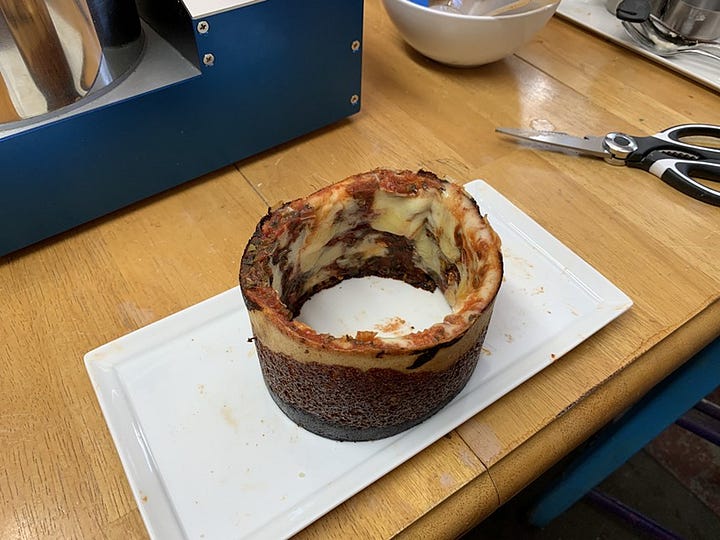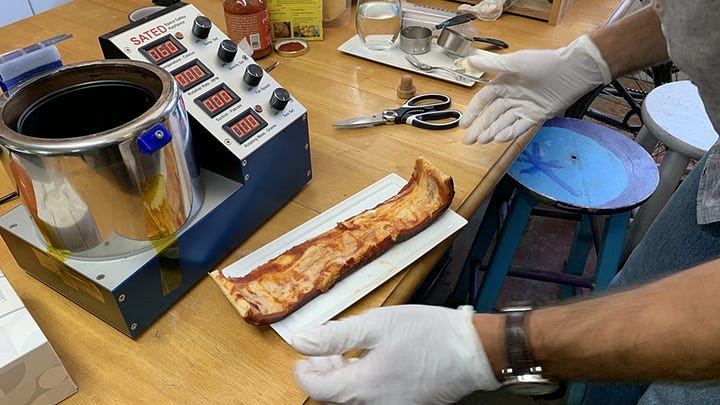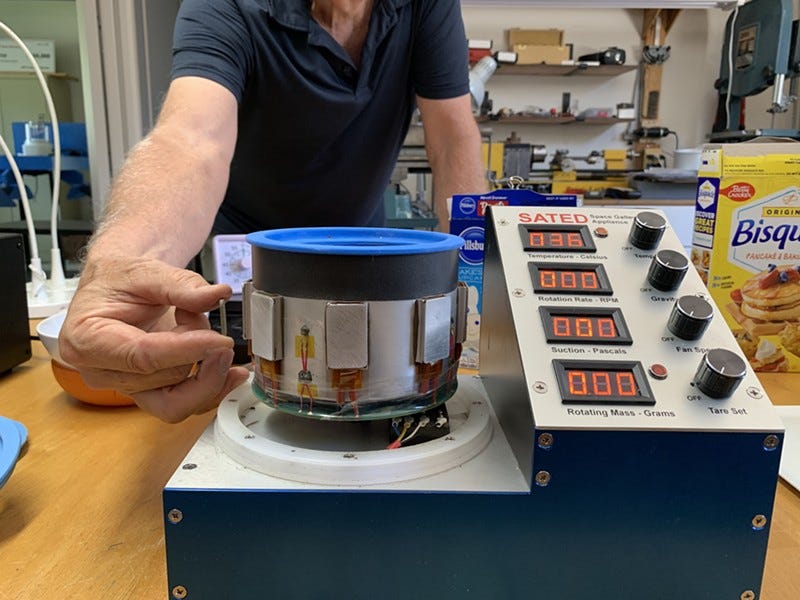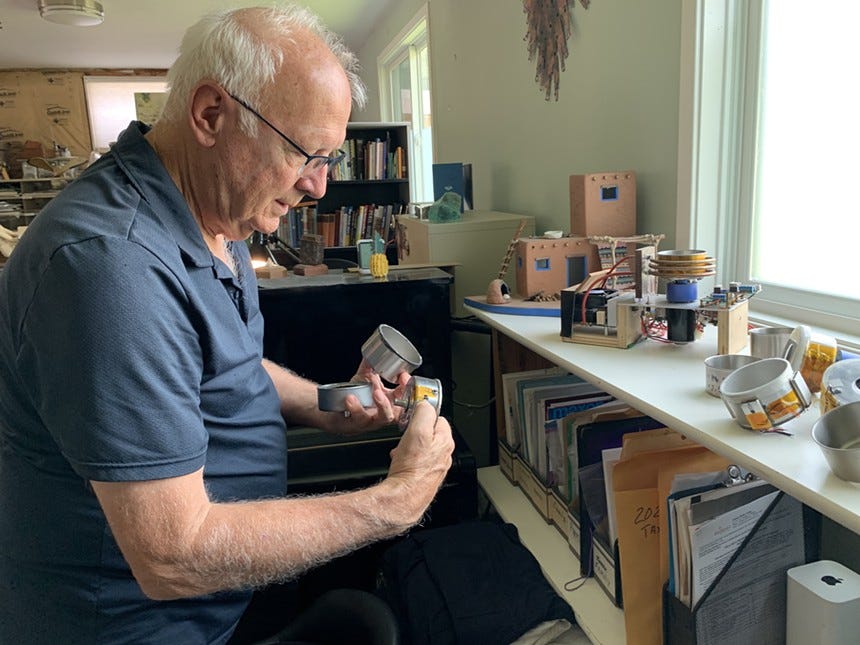People, I hope everyone had a great weekend! Today I want to share with you a very unique project—one that is literally out of this world. I always say that food brings us together, and is there any place more diplomatic and universal than space? I don’t think so! But before you say “José, are you about to become an astronaut?”, I can promise you I plan to stay right here on Earth. But my senior director of R & D, Charisse Grey, might soon experience zero gravity for herself, because she recently attended the Deep Space Challenge, an international competition where NASA invites teams to participate in a competition to create innovative food solutions for longer space missions. It’s an amazing way to bring together people of all different backgrounds and types of expertise to advance food technology in space.
One of the products that was featured in the competition is the SATED oven, which stands for Safe, Tidy, Efficient and Delicious, developed by Jim Sears of Ascent Technology in Boulder Colorado. Currently, the astronauts on the International Space Station eat meals that are similar to the Meals Ready to Eat used by the armed forces (though of course, many of those meals can be delicious, like the paella that Charisse and I developed for the International Space Station!). Jim was inspired to create an oven that would allow astronauts on long missions to safely cook, which would give them options that would taste more like home-cooked food—which would certainly be welcome for homesick astronauts on months- or years-long missions. Charisse has worked with the Ascent Team, learning how to use the SATED oven to develop food items that astronauts could cook themselves.
But instead of me talking too much about it, I’ll let you hear about it from Charisse herself!
I first found out about this Deep Space Food Challenge about two years ago and got connected to it through Ascent Technologies, initially through Roxanna (Jim Sears’ daughter). His motivation and inspiration comes from the question—how do we cook in space? They were gracious to extend an invitation for me to come work with the device, to think about how to combat all the reactions that naturally occur when you’re cooking on Earth, like steam and smoke, which you obviously can’t have when you’re in space. The device I worked with was the product of much experimentation—the first experiment was literally a tuna can that Jim used to boil water, and now this third generation space galley appliance is much more sophisticated, a really cool device.
The tool itself is a little canister that’s about six inches in diameter and it has eight heating elements. It’s hard to cook in space because you can’t actually create enough force to put the heating element up against the food product that you’re making…everything floats around freely (on Earth, gravity makes sure our food stays in the pan!). So the tool uses centrifugal force by spinning, and creates those g-forces that actually push the food against the heating elements—which allows for true cooking.
You have to be careful with temperature too, because there’s no convection in space, so hot steam can form an invisible bubble and burn a user badly. For us here on Earth, convection happens constantly, which helps things cool down when they’re cooking, and means that if you get hot steam on your skin, it’s mostly condensed without doing too much damage. But if that happens in space, it condenses on the skin and can really hurt. So there are three thermometers that read the temperature around the exterior of the canister and a vent that pre-condenses steam so you don’t get too much of the heat from the inside of the canister when you open it up after cooking.


Before I started working with Ascent, they had already created some recipes in the machine, and one thing they really nailed was pizza. They use cheese as their first layer and fat item, because it gets really crispy but also gives it some structure. Then they add in a dough that’s a lot like Bisquick, and then they add freeze-dried sausage bits, and put cheese back on the interior of the cylinder again to hold everything together. I would imagine if you’re on the ISS for a few months you probably miss some of the comforts of home, so pizza would be a welcome item to be able to cook in space (for a longer description of the R&D that went into the pizza, take a look at this article from last year).
There is talk of this device being on the ISS within 18 months, but there are still a lot of ends to connect before it goes into space, which is where having a chef join the team is useful… discussions are starting to center around, should chefs be crew members or should there be mission specialists that are chefs? I personally didn’t want to go to space, but we’re talking about testing the device and recipes on parabolic flights—a way to test zero gravity conditions without going to space—so it’s a way of testing recipes in zero gravity and also a way to train a mission specialist to cook in those conditions.
There’s a lot of research in this area at the moment, and a lot of really incredible ideas in development to solve for food in space. When I got to the Deep Space Food Challenge, I remember walking into a room with all of these biologists, all these people with really extensive education —all hypersmart people with these mind-blowing ideas for technologies, like ways to pull pure proteins out of air into a powder, which you could convert into a sauce that you could use on a pasta. There was talk of the ability to grow plants without photosynthesis. It’s all incredible, but I think what’s really special about what Jim Sears and his family have done is address the thing that makes us the most human…the desire for a good meal.
You’re probably wondering what I would cook in space! I’m Japanese from Hawaii…and I work with José, of course…so my mind immediately goes to rice, which means, if you have stock and freeze dried vegetables and protein, you might be able to successfully make paella! But this is why I’m working on this idea—we’re really getting to understand the parameters of cooking in zero gravity, understanding what’s possible, and pushing culinary boundaries as a result. It’s food in the final frontier, and we’ve only just scratched the surface.
Charisse, this is amazing. Isn’t it incredible? Thanks for sharing—and if you do go to space, don’t forget about the rest of us back on Earth!!






Absolutely fascinating! I love the cylindrical pizza format! Simply brilliant and indeed “out of this World!” 🍕💥❤️☮️😜
Super interesting as an amateur chef and a biologist